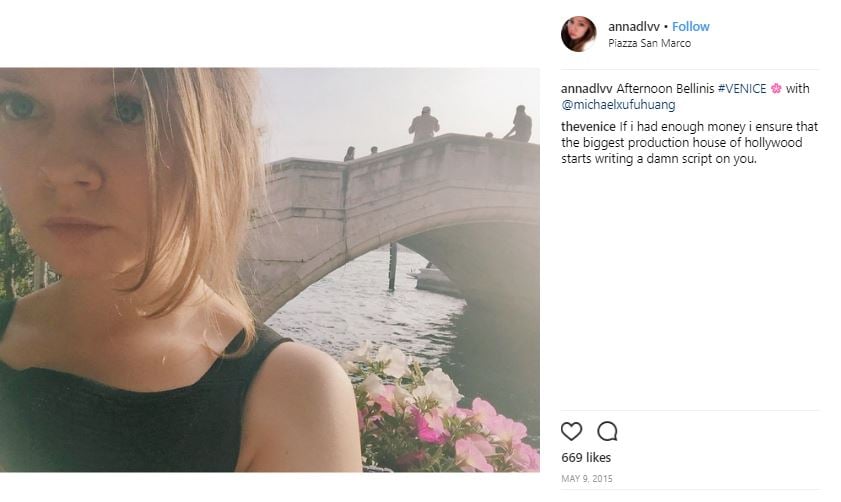Opinion
How Purple Magazine Intern-Turned-Scam Artist Anna Delvey Turned Contemporary Art Into the Perfect Tool for Fraud
Take a look at Delvey's Instagram and behold what a hollowed-out signifier art has become.

The long New York magazine article this week about Purple intern-turned-socialite scam artist Anna Delvey (real name Anna Sorokin) has people in a tizzy. It’s a juicy tale, featuring cameo appearances by the likes of Beijing collector Michael Xufu Huang—whom she swindled into paying for her to go on a lavish trip to Venice—and odious “pharma bro” Martin Shkreli. Yet it remains, after all those many thousands of words, a little unclear just what exactly Delvey’s deal was, the exact proportion of craftiness to compulsion.
In any case, it’s very much an art story, in that the entire fable that Delvey was able to spin—spellbinding people into providing the money that fueled her years-long walk on the fabulous side of New York—was that she was raising funds to build “a Soho House–ish type club… focused on art.” Art provided the circulatory system in which the grift traveled: Frieze, Art Basel, the Venice Biennale, openings at Pace Gallery, etc.
“The heart of the club would be, she said, a ‘dynamic visual-arts center,’ with a rotating array of pop-up shops curated by artist Daniel Arsham, whom she knew from her Purple days, and exhibitions and installations from blue-chip artists like Urs Fischer, Damien Hirst, Jeff Koons, and Tracey Emin,” we learn in between accounts of Delvey’s pricey dinners and extravagant hotel stays. “For the inaugural event, Anna told people, the artist Christo had agreed to wrap the building.”
This roster is a thin tissue of celebrity and scene-y artists favored by what my colleague Tim Schneider calls COINs (Collectors Only In Name), who just like to own the same kind of art #brands as the other people in their social set. Kylie Jenner revealed her collection to Vogue this week, and it’s about the same.
What interests me in the tale is how the sleight of hand that allowed Delvey to perpetrate her improbably long-lasting scam—flaunting the signifiers of wealth without the reality of wealth—is duplicated in the way a superficial association with art is so often confused with the love and appreciation of art.
Nothing in the article suggests it, but it’s totally possible that Delvey had truly interesting things to say about Fischer, Hirst, Koons, and Emin—but one guesses that she didn’t need to in order to convince the audience in front of whom she was waving their names that she was one of them. We’re a long way from the world of John Guare’s play Six Degrees of Separation(1990), where a con artist insinuates himself into the world of a family of New York art dealers by dazzling them with an intricate knowledge of culture.
You can get a sense of Delvey’s world if you look at her now-dormant Instagram, which had been a key tool to project the crisply curated fabulousness that she parlayed into a jet-setting lifestyle.
“She was a stranger to me, and yet not unknown,” Rachel Deloache Williams wrote of meeting Delvey in a Vanity Fair piece from April. (Williams is the one who ended up putting over $60,000 on a credit card to cover for Delvey’s Morocco resort vacation.) “I’d seen her on Instagram, smiling at events, drinking at parties, oftentimes alongside my own friends and acquaintances. I’d seen that @annadelvey (since changed to @annadlvv) had 40K followers.”
Delvey’s story is a kind of apotheosis of the “Instagram Effect,” where everyone projects a more perfect, happier life than they actually have via social media, and the envy generated becomes a kind of currency. Her Instagram life is stuffed full of deluxe signifiers and only rare flickers of actual sociality. The sense they cultivate is of a private and exclusive world. They are, in their arid glamor, both self-aggrandizing and kind of haughty, which is the air she projected according to copious testimony from her victims.
And, perhaps more than anything else, @annadlvv used art to project this image.
Delvey did not post a lot of photos of herself with art—too basic, I’d guess, for someone who was trying to be taken seriously as an entrepreneur. Instead, she just posted photos of artworks themselves: Félix González-Torres lightbulbs at the Whitney (a prop she returned to more than once); a Laurent Grasso on view at the Armory Show; a (prophetic) piece saying “I’m Going to Be A Very Different Kind of Star,” identified as being by Ed Ruscha, even though it is actually a collaboration between Alex Israel and Bret Easton Ellis (ironically, since these two first met each other for an interview at Purple).
A rare exception that features Delvey in it is of her silhouette projected in a Cory Arcangel work at the Kunsthalle Zürich, from 2015.
Her pics are almost always lightly but knowingly captioned, often simply identifying the artist to convey knowledge of the particular art brand (e.g. simply stating “Condo,” meaning George Condo, next to a work by the New York painter). Aside from this, the pictured art is withdrawn from any judgement or thought besides a kind of static enthusiasm.
At most, as with a July 3, 2015, pic of a Doug Aitken phone booth at Eva Presenhuber gallery in Zürich, there’s something like this: “Can’t get this #DougAitken out of my head – found my new 212 landline device.”
This is a recognizable genre of contemporary social-media image: the flat, head-on, evidentiary posting of artworks. If you want to get all Roland Barthes about it, you could say that the accumulation of these images suggest a certain “mythology.” What Barthes would call the “denotative” meaning is whatever the art in question is: Aitken, Arcangel, etc. Withdrawn from any individuating opinion, however, they are flattened together to the second-order “connotative” meaning, @annadlvv’s connection to another aspirational hybrid signified: something like “beauty-intelligence-status.”
That’s a social mythology whose cultivation is hardly unique to Anna Delvey. In fact, it is its very commonness—the way art circulates so widely as an image, as social proof, extracted from encumbering ideas—that makes the fraud so easy to pull off.
Follow artnet News on Facebook:
Want to stay ahead of the art world? Subscribe to our newsletter to get the breaking news, eye-opening interviews, and incisive critical takes that drive the conversation forward.
SHARE

No comments:
Post a Comment